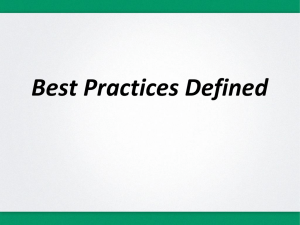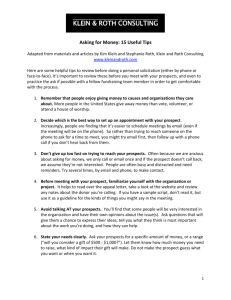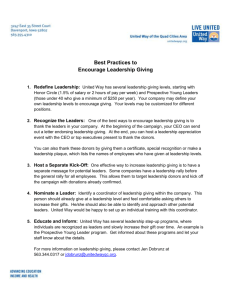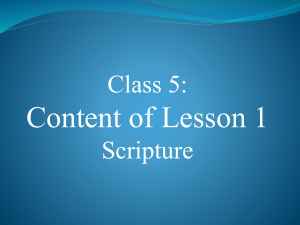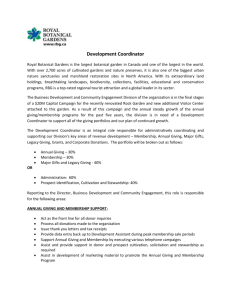Prospects handout - Green Light Fundraising
advertisement
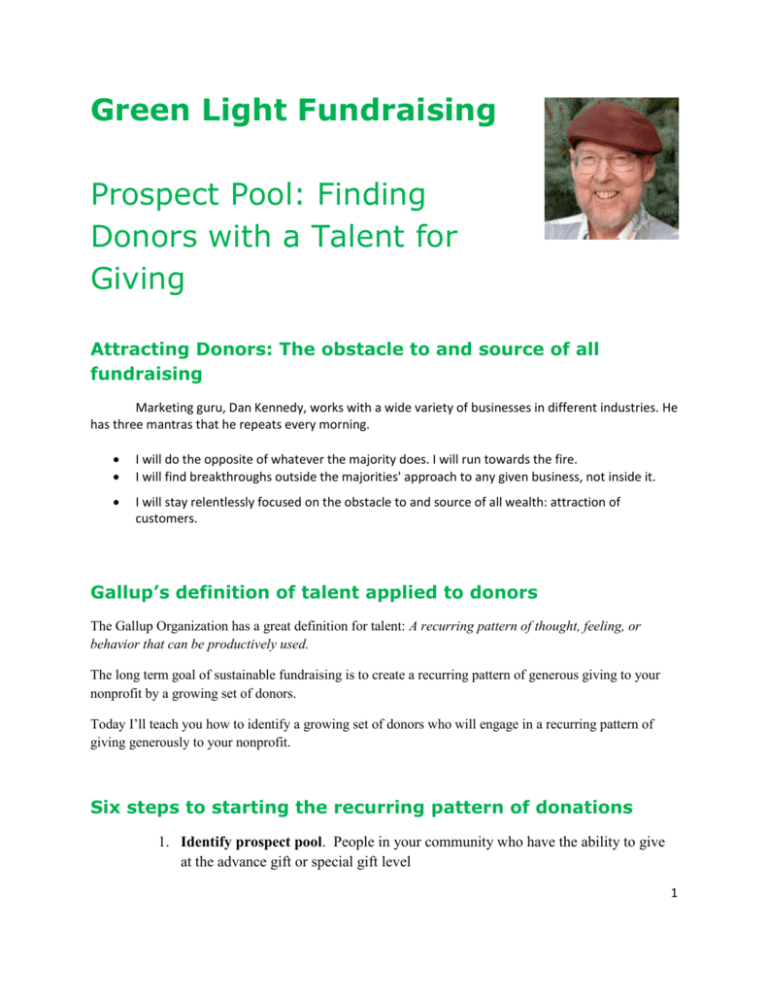
Green Light Fundraising Prospect Pool: Finding Donors with a Talent for Giving Attracting Donors: The obstacle to and source of all fundraising Marketing guru, Dan Kennedy, works with a wide variety of businesses in different industries. He has three mantras that he repeats every morning. I will do the opposite of whatever the majority does. I will run towards the fire. I will find breakthroughs outside the majorities' approach to any given business, not inside it. I will stay relentlessly focused on the obstacle to and source of all wealth: attraction of customers. Gallup’s definition of talent applied to donors The Gallup Organization has a great definition for talent: A recurring pattern of thought, feeling, or behavior that can be productively used. The long term goal of sustainable fundraising is to create a recurring pattern of generous giving to your nonprofit by a growing set of donors. Today I’ll teach you how to identify a growing set of donors who will engage in a recurring pattern of giving generously to your nonprofit. Six steps to starting the recurring pattern of donations 1. Identify prospect pool. People in your community who have the ability to give at the advance gift or special gift level 1 2. The draft. Your solicitors choose the five people they know on their team: the people they will ask face to face 3. Captivate people with your mission. From First Things First: The Ultimate Guidebook for Early Stage Nonprofits by Tom Iselin. Media and stories. a. 50% response rate if the asker knows the donor. b. 80% response rate if the asker knows the donors and the donor has an emotional connection with the mission 4. Face to Face meeting. A friend can get the meeting. 5. Ask for the gift. The golden moment in fundraising. 6. Thank and recognize the donor. Essential part of creating a recurring pattern of giving. How many potential donors do you need? Use your gift chart to determine. Rule of thumb is you need three prospects for each gift needed. http://greenlightfundraising.org/downloads/giftchart2.xls As a member of the Club you have access to a video tutorial on how to create your gift chart. Go to Club Members Home page, on the left menu, click on Coaching Calls, scroll down to Video tutorial The first planning step: Setting a tentative goal for your first year and creating a gift chart The gift chart will help you determine the number of gifts you need at every level to reach your campaign goal and the number of prospects you need for every gift Who are potential donors? The Millionaire Next Door by Thomas J. Stanley and William D. Danko Profile of the Typical American Millionaire: 57 years old, married, 3 children Two-thirds are self employed Work 45-55 hours per week 2 Median income of $131,000 Median net worth of $1.6 million Modest home (half have lived in the same home for more than 20 years) No inheritance of funds or business Inexpensive clothes 20% are retired Drive 3-5 year old American made car Avid collectors of coupons Very, very frugal Just in case you missed the last line…Very, very frugal Start with your current donors It’s much easier to obtain a donation from a current donor Identify every current donor who has the capacity to give at the special gift or advance gift levels. Add any names you know who are not donors Ask the executive director to do the same Ask board to do the same An aside about donor management software EGL uses and recommends GiftWorks Nonprofit Technology Network, NTEN, 2011 Nonprofit Data Ecosystems Report (Free for Current NTEN Members, $50 for Non-Members ($60 membership fee for nonprofits with budgets under $500,000) Further ways to build your talent pool Add names from other lists 3 Chamber of Commerce Rotary Club and other service organizations Business and Professional Women's Clubs Country Club Junior League Other organizations with members who have the capacity to give at the advance gift and special gift levels If you can’t obtain the actual lists, find a member of each group who will be willing to share names with you from memory. You now have a pool of prospects several times larger than three times the number of gifts you need. Then next step is to identify who in the prospect pool has the capacity to give at the special gifts level and who has the capacity to give at the advance gift level. Talent spotters aka the prospect committee Every community has a few people who have a talent for knowing where the money is in the community. The secret to getting them to share that information? Guarantee confidentiality. With the help of executive director, president of the board, or another board member, identify at least 10 people who know where the money is; rank them, and recruit five of them or so to serve on the prospect committee. Example of group of churches who wanted to raise funds for mission Asked pastor’s for membership list from each church Asked pastor’s to give me the names of two people in their congregation who would have the best handle on the giving capacity of the members of the church Recruited two people to be part of prospect committee 4 Your goal in developing your list is to do such a good job that volunteers will ask, “How did you get such a good list?” Ten keys to running an effective prospect committee 1. Assure confidentiality. The members of the prospect committee will be more willing to provide information to the campaign if they know that they will not be revealed as the source of the information 2. Prepare ahead of time the best prospect list possible. Your prospect committee will be able to efficiently provide you with the information you need if they start with a good list. 3. Capacity, not willingness. Emphasize to the prospect committee that their task is to rate the names based on their capacity to give, not on their willingness to give. The prospect committee determines the capacity of prospect to give while the willingness of a prospect is determined by their response to being asked by a volunteer. 4. Communicate the number of advance gift prospects needed. You know from your gift chart the number of advance gift prospects needed. Communicate that number to your talent spotters. Track the number of advance gifts prospects throughout the meeting so that your talent spotters will have a goal to shoot for and they will know when they achieve their goal. 5. Rate by three ranges. Give the committee the ranges for special gifts and advance gifts and have them rate each name as special gifts, advance gifts, or letter appeal. The appeal letter list is those who have the capacity to give at a level lower than the advance gifts and special gifts levels. 6. 60 to 90-minute meeting. People will be more likely to serve on the prospect committee if they know that their time will be respected and the meeting will last no more than 60-90 minutes. 7. Recorder. To make the meeting productive, it’s helpful for the development director or development assistant to record the input of the committee. Use three different color highlighters, using one color to highlight special gifts, a second color to highlight the advance gifts, and a third color to highlight the appeal letter level gifts. 8. Keep the meeting moving. Keeping the volunteers on track to quickly rate the names requires a tactful facilitator. The role can be played by one of the volunteers on the prospect committee, the executive 5 director, or the development director. It’s important to name the facilitator ahead of time and coach them to keep the process moving. 9. Add names. Have the committee member add names, especially names of advance gift prospects that have previously been overlooked. 10. Thank the prospect committee members. When the volunteers have completed the task of rating the names, thank them and assure them that they have played an important role in making the campaign success. Tips for getting to know advance gifts prospects 1. Identify all connections with your organization a. Past or present board member b. Past or present committee member c. Past employees. A friend and I worked as vocational counselors at same nonprofit when we were just out of college. He went on to become to CEO of a major snowmobile manufacturer. d. Family members of those who have received services. Perhaps the most powerful connection between a nonprofit and a potential donor. e. Friend of board, staff, or committee member f. Other connections 2. Signs a prospect may give. Perhaps you have someone in your community who you know has never given to your organization. You can still look for signs that they may be willing to give such as has: Given to similar causes. Served as a volunteer or board member for an organization similar to yours Friends with someone whose family has benefited from your organizations services. 3. Hobbies and other interests. When I was a nonprofit human resources director, I went to training on interviewing people. The trainer told the story of a job placement service that regularly sent applicants for interviews to a certain company. They had discovered that the interviewer was an avid fisherman. They began to coach applicants to bring up the topic of fishing during the interview and their placement rate at that company went up significantly. 6 Remember Robert Cialdini’s six universal principles of influence? Principle 5, liking: “People prefer to say yes to your request to the degree that they know and like you. No surprise there.” We tend to like people who share our interests. As you follow these steps, you will develop a great pool of people who have the potential to sustain your services through their generosity. You are now ready to learn how to teach your volunteer solicitors the GOOD way to ask for a gift. We’ll cover that topic in the coaching call after next. First… Next Coaching Call Scorecards: Tapping into your volunteers motivation for mastery Evergreen Leaders Creative Common Copyright 2012. Copyright holder is licensing this under the Creative Commons license, Attribution-Noncommercial-No Derivative 3.0 http://creativecommons.org/licenses/by-nc-nd/3.0/ You have permission to post this, email this, print this and pass it along for free to anyone you like, as long as you make no changes or edits to its contents or digital format. In fact, we’d love to have you make lots of copies and distribute them to your friends, colleagues, and clients. The right to bind this and sell it as a book, however, is strictly reserved. 7
